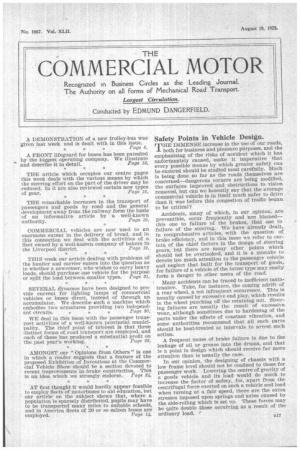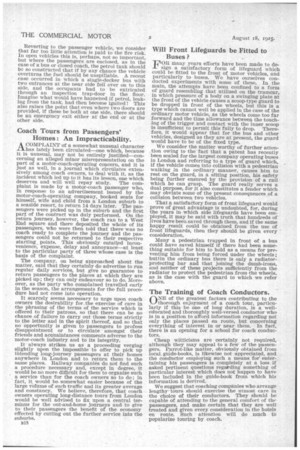Safety Points in Vehicle Design.
Page 1

Page 2

If you've noticed an error in this article please click here to report it so we can fix it.
THE IMMENSE increase in the use of our roads, both for business and pleasure purposes, and the emphasizing of the risks of accident which it has unfortunately caused, make it imperative that every possible means by which greater safety can be ensured should be studied most carefully. Much is being done so far as the roads themselves are concerned—dangerous corners are being modified, the surfaces improved and obstructions to vision removed, but can we honestly say that the average commercial vehicle is in itself much safer to drive than it was before this congestion of traffic began to be critical?
Accidents, many of which, in our opinion, are preventible, occur frequently and are blamed— this one to failure of the brakes, that one to failure of the steering. We have already dealt, in comprehensive articles, with the question of brake efficiency, and in this issue we refer to certain of the chief factors in the design of steering gears, but there are many other points which should not be overlooked, and it is a mistake to devote too much attention to the passenger vehicle and neglect that built for the transport of goods, for failure of a vehicle of the latter type may easily form a danger to other users of the road.
Many accidents can be traced to inefficient maintenance. Take, for instance, the coming adrift of a rear wheel, a not infrequent occurrence. This is usually caused by excessive end play, which results in the wheel punching off the retaining nut. Steering failures are usually the result of excessive wear, although sometimes due to hardening of the parts under the effects of constant vibration, and some authorities recommend that all such parts should be heat-treated at intervals to arrest such action. A frequent cause of brake failure is due to the leakage of oil or grease into the drums, and that is a point in design which should receive far more attention than is usually the case. In our opinion, the designing of chassis with a low frame level should not be confined to those for passenger work. Lowering the centre of gravity of a goods vehicle and its load would do much to increase the factor of safety, for, apart from the centrifugal force exerted on such a vehicle and load when turning at a fair speed, there are the extra stresses imposed upon springs and axles caused by the side-roiling which is set up. These forces may be quite double those occurring as a result of the ordinary load. 1 Reverting to the passenger vehicle, we consider that far too little attention is paid to the fire risk. In open vehicles this is, perhaps, not so important, but where the passengers are enclosed, as in the case of a bus or closed coach, the petrol tank should be so constructed that if by any chance the vehicle overturns the fuel should be unspillable. A recent case occurred in which a single-decker bus with two entrances at the near side fell over on to this side, and the occupants had to be extricated through an inspection trap-door in the floor. Imagine what would have happened if petrol, leaking from the tank, had then become ignited ! This also raises the point that even where two doors are provided, if these be both at one side, there should be an emergency exit either at the end or at the other side.




























